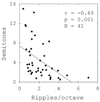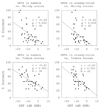Psychoacoustic abilities associated with music perception in cochlear implant users
- PMID: 20595901
- PMCID: PMC2965810
- DOI: 10.1097/AUD.0b013e3181e8b7bd
Psychoacoustic abilities associated with music perception in cochlear implant users
Abstract
Objectives: This study was designed to determine what acoustic elements are associated with musical perception ability in cochlear implant (CI) users and to understand how acoustic elements, which are important to good speech perception, contribute to music perception in CI users. It was hypothesized that the variability in the performance of music and speech perception may be related to differences in the sensitivity to specific acoustic features such as spectral changes or temporal modulations, or both.
Design: A battery of hearing tasks was administered to 42 CI listeners. The Clinical Assessment of Music Perception was used, which evaluates complex-tone pitch-direction discrimination, melody recognition, and timbre recognition. To investigate spectral and temporal processing, spectral-ripple discrimination and Schroeder-phase discrimination abilities were evaluated. Speech perception ability in quiet and noise was also evaluated. Relationships between Clinical Assessment of Music Perception subtest scores, spectral-ripple discrimination thresholds, Schroeder-phase discrimination scores, and speech recognition scores were assessed.
Results: Spectral-ripple discrimination was shown to correlate with all three aspects of music perception studied. Schroeder-phase discrimination was generally not predictive of music perception outcomes. Music perception ability was significantly correlated with speech perception ability. Nearly half of the variance in melody and timbre recognition was predicted jointly by spectral-ripple and pitch-direction discrimination thresholds. Similar results were observed on speech recognition as well.
Conclusions: This study suggests that spectral-ripple discrimination is significantly associated with music perception in CI users. A previous report showed that spectral-ripple discrimination is significantly correlated with speech recognition in quiet and in noise. This study also showed that speech recognition and music perception are also related to one another. Spectral-ripple discrimination ability seems to reflect a wide range of hearing abilities in CI users. The results suggest that materially improving spectral resolution could provide significant benefits in music and speech perception outcomes in CI users.
Figures







References
-
- Cazals Y, Pelizzone M, Saudan O, et al. Low-pass filtering in amplitude modulation detection associated with vowel and consonant identification in subjects with cochlear implants. J Acoust Soc Am. 1994;96:2048–2054. - PubMed
-
- Byrne D, Dillon H, Tran K, Arlinger S, et al. An international comparison of long-term average speech spectra. J. Acoust. Soc. Am. 1994;96:2108–2120.
-
- Collins LM, Zwolan TA, Wakefield GH. Comparison of electrode discrimination, pitch ranking, and pitch scaling data in postlingually deafened adult cochlear implant subjects. J Acoust Soc Am. 1997;101:440–455. - PubMed
-
- Donaldson GS, Nelson DA. Place-pitch sensitivity and its relation to consonant recognition by cochlear implant listeners using the MPEAK and SPEAK speech processing strategies. J Acoust Soc Am. 2000;107:1645–1658. - PubMed
-
- Dooling RJ, Leek MR, Gleich O, et al. Auditory temporal resolution in birds: Discrimination of harmonic complexes. J Acoust Soc Am. 2002;112:748–759. - PubMed
Publication types
MeSH terms
Grants and funding
LinkOut - more resources
Full Text Sources
Medical

